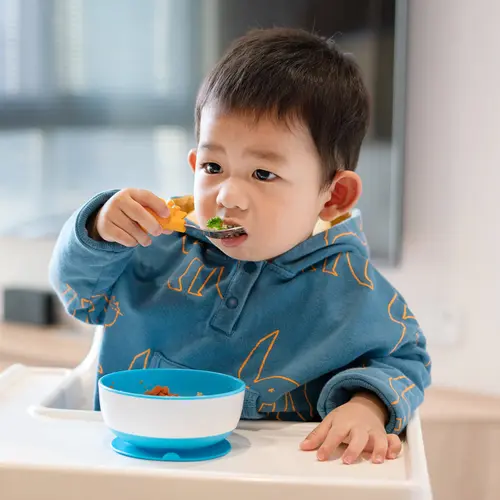You can tell children they should eat well and make healthy choices. Or you can show them that it's fun and feels good -- and they'll be more likely to do it. Here’s how:
Up the Fun Factor
Let children play with their food. Babies aren't the only ones who like to play with food. School-age children do, too. So make healthy snacks interactive.
"Serving a dip with fruit and vegetables encourages kids to eat foods they would normally push aside," says Jennifer McDaniel, RDN, LD. She’s a dietitian, sports nutritionist, and spokeswoman for the Academy of Nutrition and Dietetics.
Have kids roll a banana in peanut butter and granola. Or, make faces on cereal and open-faced sandwiches with peaches, raisins, tomatoes, and other fruit or vegetables.
Feed their creativity. Kids love creative food. Instead of handing them a piece of fresh fruit, put it in an ice cream cone.
Or, make an instant sailboat snack: Spear a triangle of cheese with a toothpick and stick it in a halved hard-boiled egg. It's just as fast as putting an egg and a piece of cheese on a plate.
Make It Easy
Show kids that you can eat healthy in a hurry:
Give them grab-and-go snack options. Cut up fruits and vegetables, and have them front and center in the refrigerator. Have snacks like string cheese, trail mix, or whole-grain crackers easy to find and grab, too. Buy them in single-serving-size packages or make your own.
Cut back on fast food. No time to cook tonight? No problem.
"Have a list of three to five things that you can make quickly, and always keep the ingredients in the house," McDaniel says.
Some quick and healthy meals: bean burritos, vegetable omelets, tuna melts (with grapes or cranberries mixed in). In a pinch, make a meal of whole wheat crackers, rolled up deli meat, baby carrots with ranch dressing, and fruit.
Make It a Family Affair
As you’ve probably noticed, your children are more likely to do what you do than what you say -- whether it's good or bad. So set a good example by being active and eating healthy. Other ways to get the whole family involved:
Have the same rules for everyone. "If you focus more on a child in the family who is overweight, it conveys the message that he or she has done something wrong," says Shannon E. Hourigan, PhD. Then being overweight feels like a personal failing. "But kids aren't in charge of what they eat, parents are." Hourigan is a pediatric psychologist at the New Balance Foundation Obesity Prevention Center at Boston Children's Hospital, and an instructor in psychology at Harvard Medical School.
Don't confuse food with love. "Baking cookies may seem like a great way to show your love," Hourigan says. "But playing outside with your children shows you care about them and their health. You're teaching them to enjoy the outdoors, you're setting a good example, and you're creating a longer memory than baked cookies will."
Jump rope, play tag or basketball, bike to the library, or explore a nearby park. If you're inside, play hide-and-seek or Twister, or dance to your favorite music.
Find balance in your family's life. Are you all overbooked? Sometimes parents worry that if their child drops an activity, she won't be able to compete with her peers, McDaniel says.
"But you need balance to be healthy. Pick which activities are really important and drop others, so that you have time for family walks and family dinners."
Cook together. Let your children find some new recipes and plan a meal - from shopping to cooking.
You want them to learn to enjoy preparing food. "The more they're involved," McDaniel says, "the more willing they will be to try new foods and enjoy healthier options."


